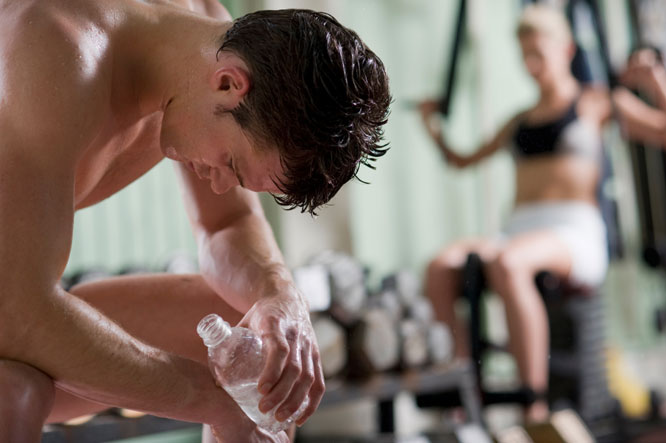28-Days-to-Lean Meal Plan
With the right plan and the right discipline, you can get seriously shredded in just 28 days.
Read article
You're on your seventh rep of heavy benches and the bar's moving ever so slowly. The eighth is even slower and the ninth even more so. At 10 you have to rack it; another rep is just not possible. You've trained to failure and you're done. But does that have to be all she wrote? Are you really at muscular failure, all fibers spent?
If you were benching 250 pounds, the failure threshold was being unable to do an 11th rep with 250—not that your pec muscles had absolutely no strength left. You could have done that 11th rep, and probably a 12th and 13th, with 200 pounds, taking you nearer to real muscular failure. Coming on top of those first 10 reps at 250, the last three reps would've stressed your pecs substantially more and led to greater muscle-fiber damage. And greater muscle damage means the body's recovery system must adapt to meet this new level of stress by building your muscles bigger and stronger. Bottom line, if you prolong the set, you prolong the intensity, increase muscle stress and enhance muscle gains.
Here we outline three of our favorite techniques for prolonging the duration and intensity of a normal set, taking you beyond accepted failure and therefore accelerating muscle gains—forced reps, rest-pause and drop sets. Each section was compiled with the expert assistance of three top bodybuilders, giving you just what you need to implement the techniques at various times in your workout. Passing grades require complete failure—beyond "normal' muscle failure, that is.

Bodybuilders commonly train to failure to maximize muscle gains, but what does research offer on the subject? Australian scientists suggest that training to failure does enhance strength gains if it isn't overused. They found that experienced lifters who did one set of bench presses to failure of their four total sets for eight weeks saw double the strength gains compared to test subjects who didn't do any of their bench presses to failure. A later study indicated that doing more than a single set to failure had no effect on strength gain; in fact, the strength gains from the multiple sets to failure were less significant than in the group doing just one set to failure. The villain holding back the multiple-sets group may well have been overtraining.
When incorporating advanced techniques into your workout, you need to factor them into your recovery time, too. "Your recovery requirement between sets and between workouts will increase when training to failure" says Mark Casselman, MS, CSCS, a high-performance training consultant, writer and speaker currently completing his PhD in eHealth Innovation at the University of Toronto (Ontario, Canada). "Taking extra time between sets allows for recovery of ATP-PC stores that you used to power your muscles through high-intensity anaerobic resistance training . Your postworkout recovery time will also be extended as a result of muscle-fiber damage, so plan for an extra day of rest after training to total muscle failure".
Training beyond failure once or twice per week can be a useful growth technique; however, constantly training with such intensity will likely result in overtraining. If you use this technique every workout, change it up and try working to the point just before total muscle failure in every other (or every third) workout. You'll likely experience a boost in gains as you move away from an overtraining-induced plateau.
Clearly, you can overdo it in your eagerness to put on size. Casselman says, "Experiment to determine the optimal amount of advanced training techniques to use in your weekly schedule".

IFBB pro Mark Dugdale
Woodinville, WA
Describe the technique and give an example of how you'd use it.
"I did a version of rest-pause in the past by doing six reps (to failure), holding the weight in the stretched, starting position with tension on the muscle for five seconds, then another couple of reps, another five-second pause, and a final rep or two to failure. Yet I recently began using the Doggcrapp training method, and now employ rest-pause this way: I choose a weight with which I can do approximately eight reps. After the initial eight reps I rack the weight, say the incline bench press, and get up and rest about 20 seconds, then I do another set with the same weight and usually get 3-4 reps, then I take another 20-second rest, followed by a final set of 1-2 reps or as many as possible. Then I immediately stretch the muscle for 60 seconds".
Why do you use this technique?
"It makes sense to me in terms of what I hold as fundamental truths regarding muscle growth. It was a natural transition from my Dorian style of training". [Editor's note: Six-time Mr. Olympia Dorian Yates was known for completing just one working set of each exercise that was taken to failure, commonly with an advanced training technique.]
When do you use it in your workout?
"So far I've used it only in the off-season, but I plan to use it right through my next contest prep. I guess you can say it's both the beginning and end of the workout, because I do only one set and one exercise per bodypart now".
Do you make other adjustments in your workout to compensate for the increased intensity?
"I've cut down on the total volume of training but have actually increased the frequency by going from training each bodypart once in seven days to twice in nine".
What's the secret of making it work for you?
"Complete focus and documenting my weights. I have to go balls-out every time and make sure I lift either heavier weight or do more reps with each new workout. I try and beat my previous best in some manner".
Your rest period is 20 seconds; how do you know if that's the right length of time?
"You need to try a couple of exercises with various intervals; 20 seconds seems to work well for me. It allows me just enough time to go all-out for a few more reps".
Are there any special considerations you need to account for when using this technique?
"Machines are sometimes safer, but I prefer free weights. A good spotter is also helpful because you can't lift super-heavy and go to failure without someone there to assist you. My last rep or two on each segment is a forced rep with the assistance of a spotter, so I'm actually combining forced reps with this technique".
Do you take a longer break between sets when doing this to ensure maximal recuperation?
"Yes, but with only one exercise and one set per bodypart, the workout moves pretty quickly. My goal is to always be in and out of the gym within an hour or less".

IFBB pro Garrett Downing
San Diego, CA
Describe the technique and give an example of how you'd use it.
"A forced rep is one that's done with the assistance of a spotter after you reach failure under your own power. In most cases, 2-3 additional reps are the norm. Forced reps are most commonly done with exercises such as the bench press – moves that afford the spotter easy accessibility to the bar and maximum safety. After I complete as many reps as I can on my own, the spotter then provides assistance by just touching the weight with enough help to keep the rep moving. I'm still in control of the weight".
When do you use it in your workout?
"I usually perform forced reps during my last set of an exercise, although they can be used for multiple sets. You really have to gauge your rest and recuperative time to get your timing down. Doing too many forced reps early in your working sets can be too much too soon, but forced reps can be done on most exercises as long as you have a good spotter. I find them helpful when doing chest and pressing movements during any phase of training".
Are some exercises better than others to use with this technique?
"If you're doing a regimen that requires a lot of forced reps, you might want to stick to machines and barbell exercises, at least when you start to fatigue. Dumbbells can be difficult to spot".
Do you make adjustments in your workout to compensate for the increased intensity of forced reps?
"I almost always have to make some adjustments to my routine. There's no way to do forced reps on every set for every exercise. That's why it's necessary to reduce the number of sets or adjust the rep range when you're increasing the intensity for a particular set(s)".
What's the secret of making forced reps work?
"It's important not to employ them on a regular basis. Before I knew anything about training, I'd routinely do forced reps just about every day of every workout. I never saw gains, and instead of my strength going up, it was stagnant or went down. This was due to lack of rest and a constant bombardment on my muscles".
How much help should your partner give?
"The help should be just enough to get you past the sticking point. This is just a slight tap of the bar; any more than that and it becomes a workout for your spotter. Your spotter should never have his hands on the bar for every rep. Once the lifter is in need of a spot, the spotter engages the bar with just enough of a push to assist. Usually, 2-3 reps are sufficient for several sets".
Do you take a longer break between sets when doing this to ensure maximal recuperation?
"Absolutely. You need to give yourself adequate rest between sets or you won't make it through your workout".

2002 NPC Middleweight Champ Stan McQuay
Canoga Park, CA
Describe the technique and give an example of how you'd use it.
'Drop sets can be used to take a set to the point of failure; instead of just stopping, immediately reduce the weight and continue the set. This drop in weight can be done two or more times for a single set. Let's say I was doing dumbbell curls. I'd start with a heavy set of 70-pound dumbbells for 10 reps or so, set the weights down and immediately grab a pair of 60s for another 10 reps or as many as I can".
Why do you use this technique?
"I favor drop sets because it keeps the set going, and that ignites a greater pump and forces more blood into the muscle".
When do you use drop sets?
"You can use them at the beginning or end of your workout, off-season or precontest and with any bodypart. It's good to throw variety into your training to confuse the body for better growth".
Are some pieces of equipment better suited for doing drop sets?
"Drop sets can be done on any exercise, but some are more difficult to make changes on and take longer, lengthening that very brief rest interval and reducing the pump. Having to pull plates off an Olympic bar or some machines takes time, while pulling and reinserting a pin is fast and easy. With dumbbells, it's best to have the necessary weights right by you so you don't have to scout for them after you complete the first part of your set".
Do you reduce the volume in your workout to compensate for the increased intensity?
"I'll cut back on total sets. When I train traps, for example, I'll do just one long drop set, meaning I start off with a heavy pair of dumbbells (150 pounds) and perform 10 reps. Then I work my way down the rack, dropping the weight 10 pounds each set until I reach my last pair of dumbbells, typically 50s. Just one long set is enough, since in that one set I'm taking myself to the limit".
What's the secret to making it work for you?
"Just hard work and staying focused. The pump and the burn should stimulate an addiction to this way of training".
In terms of percentage, how much weight do you drop?
"It varies with the exercise and bodypart I'm working. For shrugs, I'll drop just 10 pounds, but sometimes it's more than that, maybe 25% of the weight. That's something you develop a feel for as you gain experience using the technique, but the key is taking each weight or stage to a point of failure before going to the lighter weight".
Do you take a longer break between sets when doing this to ensure maximal recuperation?
"How much I rest depends on the muscle group I'm training and the moves I'm doing. My rule of thumb is 90 seconds for a typical set. When doing drop sets with smaller bodyparts, I'll stick to my rule of 90 seconds. But when performing drop sets with squats, I'll extend my recuperation time to whatever length I need to fully maximize the exercise and the technique".
Notifications